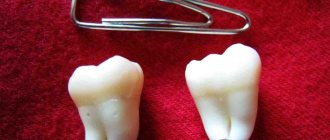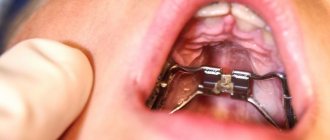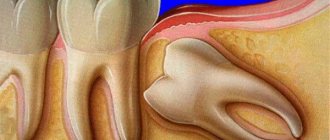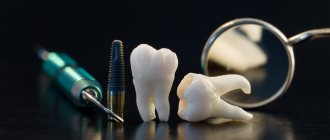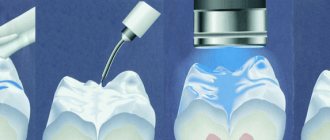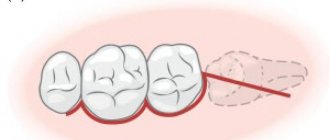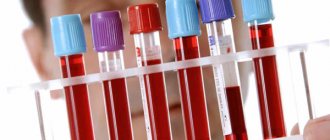Over the past few thousand years, the human jaw has narrowed by 10 centimeters. It turns out that the “eights” now do not have enough space, so their growth is accompanied by severe pain, swelling of the mucous membrane, inflammation and other problems.
The lower wisdom teeth usually hurt because the lower jaw bone is denser. The upper extreme molars erupt painlessly, but can rest against the cheek, injuring it.
Why does my gum hurt when my wisdom tooth grows?
Atypical growth
When the “figure eight” erupts, it is not the tooth itself that hurts, but the soft tissue surrounding it. This is a reaction to irritation of nerve endings. Most likely, the tooth grows at an angle and rests on the gum, which is why it responds with pain. Sometimes the outer molar lies horizontally and over time begins to injure the “neighbor”: it seems to you that your wisdom tooth hurts, but in fact it is a “seven”.
Pericoronitis
When teething becomes difficult, a gingival hood forms, covering the wisdom tooth. Under this gingival fold, food debris and bacteria get trapped, causing an inflammatory process - pericoronitis. Excruciating aching pain, swelling, redness (hyperemia) appears, and purulent exudate accumulates.
Trigeminal neuralgia
Sometimes a wisdom tooth presses on one of the branches of the facial (trigeminal) nerve, and then severe radiating pain occurs that literally covers half of the face. It seems that your throat, ear or head hurts, but the reason for everything is the ill-fated wisdom tooth.
Symptoms of figure eight eruption
In each case, the signs of the imminent appearance of the last units in the series are felt differently. For some, this process is subtle and hardly differs from the eruption of other permanent teeth, but in most cases it is accompanied by a number of complications:
- Painful sensations are due to the fact that the predecessors of the figure eight do not exist; they have to make their way all the way through hard and soft tissues from scratch. And such ruptures make themselves felt with intense pain. In addition, there are other reasons why this feeling occurs.
- The gums and sometimes the cheek swell, which indicates the formation of serious complications, for example, pericoronitis, when the gingival hood above the wisdom tooth becomes inflamed.
- Elevated body temperature also indicates tissue rupture, and in some cases indicates a pathological process.
- It is difficult to open your mouth - such difficulties are associated with the fact that inflammation spreads to the masticatory muscles and leads to a number of unpleasant consequences that should not be ignored.
- It is painful to swallow - indicates the development of a purulent abscess, phlegmon in the eruption area.
If the temperature rises, the gums hurt and there are any other unpleasant symptoms that accompany the teething process, then you need to immediately consult a dentist. A specialist will determine the cause of this phenomenon and suggest the best way out of the current situation.
What to do and how to rinse
If your wisdom tooth is growing and your gums hurt, you need to urgently consult a dentist. This is the best you can do. You shouldn’t endure pain either, so at first you can take a painkiller tablet and rinse your mouth every 2-3 hours to relieve inflammation.
Suitable rinses:
- soda-salt solution - 1 teaspoon each of salt and soda and 1 glass of warm (but not hot) boiled water;
- antiseptic from a pharmacy - a solution of miramistin, eludril or a cheaper analogue - chlorhexidine - works well, they are sold in any pharmacy;
- decoction of sage, chamomile or oak bark (room temperature) - 3-4 tablespoons of the mixture should be poured into 0.5 liters of boiling water, left for an hour, and then strained;
- solution of alcohol tincture of propolis - 10-15 drops per glass of water is enough.
These drugs relieve swelling well and have a bactericidal effect (inhibit the activity of pathogenic microbes). And herbal infusions contain organic tannins, which have astringent properties and prevent suppuration in the mouth.
Stop self-medication immediately and consult a doctor immediately
If rinsing does not give positive results, or the condition worsens, then it is necessary to contact a dentist as soon as possible. Only at first glance does it seem that strong painkillers and rinses will save the situation, but there are cases that only a specialist can handle. If the following signs occur, you must stop all rinsing and self-treatment procedures and immediately contact a dental clinic:
- Severe inflammation, bleeding gums, pulsation at the site of the tooth, in the ear, temples;
- Unpleasant odor, taste of pus in the mouth;
- Bleeding;
- Restricted jaw mobility;
- Pain that cannot be relieved with standard painkillers;
- Fever, nausea, headache;
- Swelling of any part of the face from the inflamed gum;
It must be remembered that the wisdom tooth is located near the nerve endings, including the organs of hearing, vision, and respiratory system. Unfortunately, there are cases of disability and several deaths, the causes of which were untimely treatment and lack of qualified assistance during the period of wisdom tooth eruption.
Postponing a visit to the dentist is currently one of the most erroneous actions, since it is better to cope with the problem at the initial stage, and the accompanying signs of the appearance of a wisdom tooth are no exception. This will help maintain the health of not only the entire oral cavity, but also the body as a whole.
Painkillers
In your home medicine cabinet you will probably find a remedy that will help relieve excruciating pain. But remember: any pill only temporarily relieves symptoms, but does not solve the problem as a whole. Therefore, you can’t put off going to the dentist!
General analgesics
It is recommended to take a tablet of Ketanov, Nurofen, Analgin, Etoricoxib or other analogues. The analgesic effect lasts from 1 to 5 hours. Sometimes the analgesic does not work. In this case, you cannot increase the dose of the drug; follow the instructions. Overdose causes poisoning and other serious complications.
Anti-inflammatory drugs
Ibuprofen, Paracetamol, Diclofenac and other anti-inflammatory drugs are also taken orally. They provide an analgesic effect and relieve fever, which often rises with problematic growth of the figure eight.
Topical ointments and gels
Gel Kamistad, Metrogyl Denta, Cholisal and the like give an analgesic, antibacterial and wound-healing effect. After application, the gums “freeze” for some time – 2-3 hours. Instead of ointment or gel, Angilex anesthetic spray is also used.
You can apply a piece of ice or something cold to the cheek where the tooth hurts. But do not overdo it - 5-7 minutes will be enough, otherwise severe hypothermia can lead to tissue necrosis.
Attention: do not take antibiotics without a doctor's prescription!
Ways to make teething easier
If there is discomfort during the appearance of a wisdom tooth, it is advisable to contact a dentist so that, based on x-rays and examination, he decides on the possibility of excision of the gums and checks the correct growth of the tooth.
If the pain and swelling of the gums are minor and the tooth comes out correctly, you can try to relieve the pain yourself using the following methods:
- One way to relieve minor wisdom tooth pain is to chew gum . She will gently massage the painful area and provide temporary relief.
- Use a mild local anesthetic. Painkiller gels such as Cholisal and Kamistad can be purchased without a prescription in pharmacies. Simply apply a small amount to the affected area to soothe the pain.
- Try a warm salt water rinse . It will help relieve moderate pain without the use of medications. Rinse your mouth with salt water for 30 seconds. Be careful not to swallow. You can add a spoonful of soda to the salt.
- Over-the-counter pain relievers . Paracetamol, ibuprofen and other medications will help relieve pain associated with the eruption of wisdom teeth. Follow the directions on the package to ensure you know the correct dose. If you have any contraindications or are taking other medications, consult your doctor before starting any treatment.
- Cold compresses or ice packs are also a popular way to relieve toothache, but if the pain is so severe that you need this remedy, you should visit your dentist as soon as possible.
- Garlic. A home remedy that has analgesic properties that will help reduce inflammation and pain.
- Try folk remedies : rinsing with infusions of sage, oak bark, and turnip decoction.
Gum massage will help relieve pain; make sure all movements are gentle and light. They need to be done with your fingertips, without pressing or scratching with your nails, so as not to cause an infection.
During the massage, you can use sea buckthorn or clove oil or use pharmaceutical painkillers, gels or ointments.
When teething, the gums may peel off from the tooth, this is a normal process, but if the lymph nodes begin to enlarge, and the gums become swollen and itchy, you should immediately consult a doctor for advice, as this area may have become infected.
Folk remedies for wisdom tooth growth
“Grandma’s recipes” also help relieve pain and inflammation when wisdom teeth grow.
- Prepare turnip broth: take 2-3 tablespoons of grated turnip, add water and cook for 10-15 minutes. When the broth has cooled, rinse your mouth with it every hour.
- Pine cones and branches are also suitable. The ingredients are boiled for 10 minutes and mouth baths are made from the cooled infusion.
- Onion peel is another useful component for preparing pain-relieving baths. Take the peels of 3 onions, pour half a liter of boiling water and leave for an hour. Take a little infusion into your mouth and hold for 20 minutes.
- You can take a cucumber or potato, put it in the freezer, after cooling, cut off a piece and apply it to the gum.
Surgical methods of treatment
In 90% of cases, problematic wisdom teeth are removed. The operation is planned only after X-ray diagnosis. The doctor must examine the condition of the tooth, the shape and position of the roots in the picture, and assess all the risks.
First, the gingival hood is excised using a surgical scalpel. Then the doctor cleans out the accumulated plaque and purulent exudate, and then washes the wound with an antiseptic. If the wisdom tooth is located vertically and occupies a normal position in the row, then there is no need to remove it.
In case of dystopia (position at an angle), removal is prescribed - the “figure eight” is pulled out with hand forceps. If the unerupted tooth lies horizontally, then it is sawed with a drill and taken out in parts, and the wound is sutured.
The operation lasts 10-40 minutes, depending on the task. The manipulations are carried out under local anesthesia, you will not feel pain.
What to do if a tooth grows during pregnancy
If a wisdom tooth grows during pregnancy, surgery is contraindicated, as this is a great stress for the child and the expectant mother. In addition, there is a risk of complications, for example, after tooth extraction, the temperature may rise or bleeding from the socket may occur. This must not be allowed!
In this case, it is recommended to use physical therapy or medication to relieve inflammation and pain. You can drink no-shpa or rinse your mouth with chlorhexidine. However, any medications should be used strictly as prescribed by the doctor; the doctor will prescribe medications that do not penetrate the placental barrier.
Possible complications during wisdom tooth growth
What problems await you if you don’t go to the dentist on time?
- Firstly, atypical growth of the figure eight and advanced pericoronitis can lead to deformation of the dentition and malocclusion.
- Secondly, the swelling can be so severe that the proportions of the face are disrupted, and the person cannot open his mouth even a centimeter. Against this background, the submandibular lymph nodes become enlarged and painful.
- Thirdly, any, even the slightest inflammation tends to progress. Bacterial infection and pus penetrate under the gum, affecting the deep periodontal tissues. In rare cases, sepsis (blood poisoning) and death may occur.
At risk are patients with weak immunity, a depleted body after a cold, stress or diet. So don’t put off your visit to the dentist!
More detailed information about excision of the hood of a wisdom tooth is in our article.
Causes of gum inflammation
Pericoronitis
A situation that happens to every second patient in a dental clinic - inflammation around the wisdom tooth.
By their nature, all human teeth have their predecessors during their growth and development - milk teeth. By the age of 17-20, all of them are replaced by molars at a time when the third molars are just beginning to grow and erupt. This moment takes a lot of time and is accompanied by various complications: gingivitis, stomatitis, infected carious lesions, pericoronitis (if the gums near the wisdom tooth are inflamed).
The development of wisdom teeth begins with the rudiments on each jaw. Their presence does not guarantee future growth, since most of them do not have time to properly erupt or are completely located under the gum tissue. Such moments are often accompanied by inflammation and pain.
The causes of an inflammatory reaction around a wisdom tooth can also be:
- poor oral care (due to difficult access with a regular brush, such places become covered with plaque, after which tartar forms with inflamed gums);
- changeable hormonal levels;
- thermal and mechanical damage to the gums;
- accompanying illnesses;
- figure eight caries.
Cutting through the figure eight
One of the main causes of an inflammatory reaction is the eruption of wisdom teeth. This process is long and painful. It all depends on the initial position of the molar under the gum, its crown and growth rate. The longer the third molar, whose upper edges are sharpened, grows, the more painful eruption will be. In addition to pain, teething may be accompanied by the following complications:
- bleeding;
- increased body temperature;
- general weakness, chills;
- purulent infection.
If your gums bleed and give your mouth an unpleasant odor, you should immediately consult a doctor to decide on possible surgical intervention to excise the gum that is interfering with the growth of the figure eight.
Damage to an old tooth
Inflammation of the wisdom tooth hood
If the old molar is positioned incorrectly, its growth will be similar. When located under the gum or half-erupted, a wisdom tooth hood forms. If this area is poorly cared for, caries occurs on the surface of the figure eight. This phenomenon will be characterized by inflammation around the molar and the appearance of pus under the hood, accompanied by severe pain. The presence of a purulent lesion triggers the intoxication syndrome - the appearance of general weakness, an increase in temperature with chills.
Symptoms of wisdom tooth inflammation
Let's look at how to clinically recognize inflammation of a wisdom tooth.
The first sign of the development of an inflammatory reaction will be pain.
The nature of the pain will depend on:
- duration of growth of the third molar;
- gum thickness above the site of eruption;
- direction of growth;
- places in the oral cavity;
- location of the adjacent molar.
The process of wedging a sharp crown into the inner layer of the gum begins to bother the patient. As the figure eight moves through the thickness of the mucosa, it causes increased pain. During the interview, the patient can point with his finger where it hurts, guiding the dentist to the right decision even in the absence of inflammation.
The second sign is pericoronitis (inflammation of the gums near the wisdom tooth) with swelling of the gum tissue.
With poor oral hygiene or prolonged growth of the third molar, an inflammatory crown appears around it. In advanced cases, the cheek may swell and fester. If you do not contact a specialist in time, there is a possibility of phlegmon or an abscess.
The third sign of inflammation is the general response of the body (in the presence of a purulent infection) with the development of intoxication syndrome. Body temperature will increase (up to 38.0), chills will appear.
